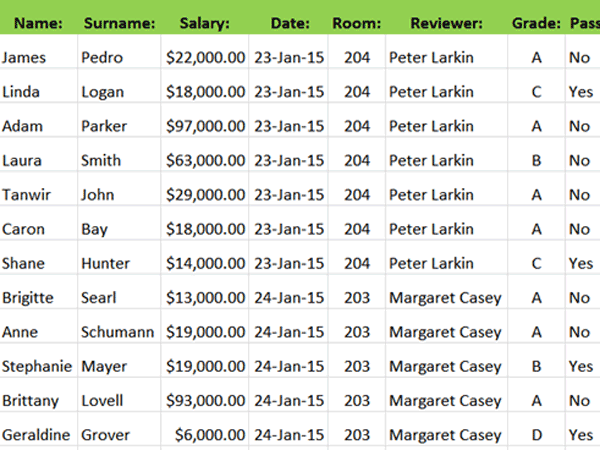www.TestsTestsTests.com
Printing Basics Excel Tutorial
Excel 2010 Training –
Printing
Free Online Microsoft Excel Tutorial
* Print Preview
*
Set Paper Size and Layout
* Repeat a Heading Row
* Page Break Preview
Usually you will need to print your worksheet. Print Preview will let you see what your worksheet will look like when it’s printed. Then you can change margins, paper size and layout, page breaks and column widths and print the cell borders and column headings at the top of each page to make it easy to read.
Test your Excel skills with the corresponding FREE Online Multiple Choice
Printing Basics Excel Test
* Print Preview
To avoid any interesting printing surprises, it is extremely advisable to always do a Print Preview of your workbook before pressing print. If your worksheet contains many columns of data, Excel will automatically break these off into A4 paper size and your work-of-art spreadsheet could end up printing over hundreds of pages. Although this may sound like a great conversation starter when you are standing at the printer waiting for aforementioned hundreds of pages to print, your level office credibility may decrease with each printed sheet that contains only a few lines of data!
Other than avoiding damaging your office cred, Print Preview also offers an array of useful options for changing the layout, margins and other print settings for your worksheet and is possibly one of the most important skills to learn after basic data entry in Excel.
To view your worksheet in Print Preview:
1. With the worksheet you wish to view open, click on the File tab to launch the Backstage View.
2. In the left-hand panel select the Print tab by clicking on it once.
3. This will launch the Print Preview area of the Backstage View. The panel to the right (circled in yellow in the screenshot below) displays what your worksheet will look like when you print it:

Study the Preview panel closely to ensure that your worksheet will print correctly. Also examine how many pages the worksheet will print over in the Pages box in the bottom left-hand corner of the Preview panel (circled in yellow in the screenshot below:

Use the Next Page and Previous Page buttons located on either side of the number of pages box (circled in yellow in the screenshot above) to navigate through all the pages in your worksheet.
The number of pages indicated is often the first sign that something is not right. For example, the worksheet above only contains a couple of rows and columns of data and should definitely not print over 24 pages. This could mean that there are unnecessary page breaks in the worksheet, print areas have been set to repeat or a blank section has been included in the data selection to print.
Another issue that is commonly picked up in the Print Preview pane is when data will print so small as to be illegible and not worth printing on a single sheet. This could be as a result of unrealistic Page Breaks being set or the data has simply been formatted incorrectly.
If you are happy with the Preview of your document, press on the Print button to go ahead and print the worksheet. To exit the Print Preview area and fix any issues, click on the Home tab or press Escape on your keyboard.
TIP: A shortcut for going to the Print Preview area is to hold down the Ctrl key on your keyboard whilst pressing the P button (Ctrl+P).
*Set Paper Size and Layout
If your worksheet is not quite fitting onto a traditional A4 or if you need the layout to be landscape, the page margins slightly bigger or smaller or to change the Paper type to a different type, such as Letter or A3, you can access all these options quickly in the Print Preview screen.
To change the Paper type for printing your worksheet on:
1. Ensure you insert the correct paper size and type into the relevant tray of your printer.
2. Click on the File tab and then on the Print tab or press Ctrl+P on your keyboard, to access the Print Preview area.
3. Click on the dropdown box labelled A4 by default (circled in yellow in the screenshot below).

4. Select the desired paper size from the list of available paper sizes or click on More Paper Sizes at the bottom of the list for further options.
To change the page margins of the pages your worksheet will print over:
1. Click on the File tab and then on the Print tab or press Ctrl+P on your keyboard, to access the Print Preview area.
2. In the Print Preview area’s click on the dropdown box labelled Normal Margins (it an also contain other margin settings if it has been changed from the default) (circled in yellow in the screenshot below) and either select one of the pre-set margin options in the list or click on Custom Margins at the bottom of the list to access further margin options.

The pre-set margin types are Wide which inserts large margins, Narrow, which inserts small margins and Normal which inserts default margins.
To change the Page Layout for printing your worksheet:
1. Click on the File tab and then on the Print tab or press Ctrl+P on your keyboard, to access the Print Preview area.
2. Click on the dropdown box labelled Portrait Orientation and select Landscape Orientation (or Portrait Orientation if the current layout is Landscape).
It is common for worksheets in Excel to be printed in Landscape Orientation as this allows space for more columns to be included on the same page.
* Repeat a Heading Row
This is a really neat printing feature by which you can have the heading row (or rows) of your worksheet print on every page when your worksheet is printed. Imagine you have a worksheet containing employee data that runs across multiple rows and when printed, equals around 20 pages. Without repeating the header row, it may be difficult to read subsequent pages without having to refer back to the first page that contain the heading row.
Study the example below:

The worksheet above contains literally hundreds of rows and prints over several pages. It is easy to see that without the title row providing labels for what the data in each column means, it would become difficult to read on subsequent pages.
To Repeat a Header Row on every page when printing a worksheet:
1. Open the worksheet you wish to print.
2. Click on the Page Layout tab on the Ribbon.
3. In the Page Setup group, click on the Print Titles button. This will launch the Page Setup dialogue box.
4. Under the Sheet tab look for the Print Titles heading and click in the box next to Rows to repeat at top (circled in yellow in the screenshot below):

5. With your cursor in the box next to Rows to Repeat at top, click back in the worksheet and select the row or rows you wish to print as a repeat header at the top of each page by clicking on the row label(s). You have to select the entire row regardless of the area containing the data. The row you select does not have to be the top row. If you select multiple rows to print at the top of each sheet, they must be contiguous (directly following each other).
6. Once you are satisfied with your selection, press OK to close the Page Setup dialogue box.
To preview whether the correct row(s) is repeating as expected, go to Print Preview (Ctrl+P) and scroll through the pages to view what the sheets will look like when printed.
Columns can also be repeated should they contain labels you need printed on every sheet, however, this is less commonly used than the Repeat a Heading Row feature.
* Page Break Preview
Page breaks in Excel can appear confusing and unpredictable as they work both horizontally and vertically. Lucky for us, the Page Break Preview option not only allows you to see page breaks visually, it also allows you to manipulate them by moving them around.
To view where page breaks appear in your worksheet:
1. Click on the View tab on the Ribbon.
2. In the Workbook Views group, click on Page Break Preview.
3. The display of your worksheet will change to look something like the example screenshot below:

From this view we can tell how man pages the worksheet will print over and also where the pages are divided by page breaks vertically as well as horizontally.
Drag the vertical and horizontal blue lines to create fewer pages by extending them to the edge of the data or change where rows or columns will cut off and print over separate pages by moving the lines. Use the Margins and Orientation buttons in the Page Setup group under the Page Layout tab to change the page margins and layout to aid you in quickly fitting columns or rows on the same page.
After rearranging where vertical and horizontal page breaks appear, view your worksheet in Print Preview to ensure all is well before printing.Now you have done the tutorial…
Test your Excel skills with the corresponding FREE Online Multiple Choice
Printing Basics Excel Test



